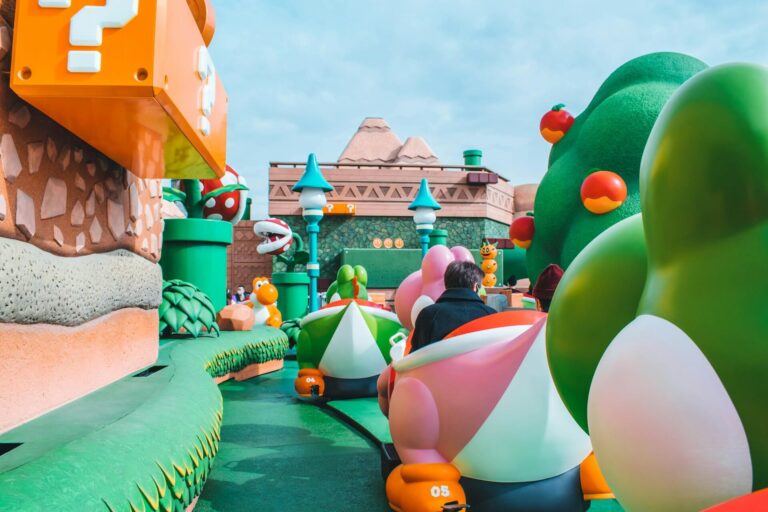In today’s eco-conscious environment, the pursuit of fun and entertainment often finds itself at odds with a growing awareness of environmental sustainability. For those of us concerned with the impact of our festive choices, a question looms large when it comes to inflatables, towering castles, and whimsical play structures that serve as the centerpiece for many celebratory occasions. How do we reconcile the joy they bring with their hidden environmental consequences?
The Breath of Consumption
This website acknowledges the importance of starting at the source – the production of these inflatables. Shockingly, most inflatables are made from materials that are not biodegradable and derived from petroleum. Additionally, the production process itself contributes to the pollution of our planet. As conscientious consumers, let’s consider the environmental impact of our choices and make informed decisions before purchasing inflatable products.
The Lifecycle of an Inflatable
From raw material extraction and manufacturing to the distribution network that spans miles, each step in the lifecycle of an inflatable rental involves energy consumption and waste generation.
Extraction and Creation
PVC is not only derived from fossil fuels but also requires a chemical-intensive process to turn it into the pliable material used for inflatables. This initial stage is incredibly energy-intensive and produces a range of hazardous by-products.
Distribution
The impact extends as these products are distributed. The fuel used in the transport adds to the carbon footprint, and the packaging needed for protection during shipment contributes to waste.
The Final Act – Disposal
Disposing of an inflatable involves complexities beyond simply throwing it away. These aren’t the same as deflating a pool float. Inflatables are often too large to fit into a standard trash receptacle and aren’t recyclable in most municipal systems, which leaves traditional methods of disposal to landfilling or incineration, further polluting the air and soil.
The Paradox of Fun
As we grapple with the environmental truth of inflatables, a paradox emerges. They have the potential to promote environmental education and act as a canvas for artistic expression. The same pillars that make inflatables an impactful teaching tool about nature – their towering scale and vibrant colors – make them an evocative medium for artists to bring attention to ecological themes.
Education by Elevation
Inflatables possess the unique ability to captivate attention and imagination. When used to illustrate natural phenomena or make wildlife replicas larger than life, they can be powerful educational tools that inspire action and a connection to the environment.
Eco-Inflatable Trends
From inflating whale replicas at beach cleanups to creating mobile planetariums for stargazing in urban areas with light pollution, eco-friendly inflatable usage is on the rise.
Deflating the Environmental Impact
Thankfully, not all inflatables and rental companies are created equal. An increasing number of businesses are recognizing their part to play in preserving the planet and are taking steps to minimize their environmental impact.
Sustainable Alternatives
The inflatable market isn’t immune to the rise of sustainable alternatives. Some companies are turning to biodegradable materials, like TPU (thermoplastic polyurethane), or organic cotton, though these options come with their own set of trade-offs, such as increased cost and decreased durability.
Reducing the Footprint
Inflatables are being designed with sustainability in mind, with efforts to reduce the environmental impact in various ways. Some companies have adopted practices such as using solar-powered facilities, implementing water-based printing dyes, and investing in durable designs meant to last through numerous events.
Responsible Disposal
To combat the issue of post-party waste, companies are fostering take-back or recycling programs to ensure that inflatables don’t end up in landfills. Inflatable amusements designed to be disassembled and their components recycled are also becoming more common.
The Inflatables of Tomorrow
The future of inflatables may lie in technology and innovation, as designers and manufacturers work to conceive inflatables that are not only kinder to the environment but also challenge the norm. Imagine bioluminescent inflatables powered by the sun, or inflatables that double as water filtration systems.
Innovation Overhaul
Cutting-edge technologies can transform the inflatable industry. Integrating RFID for smarter, inventory-aware play structures, or developing inflatables that harvest wind energy are initiatives being explored for the next generation of inflatables.
Smart Designs
The focus on intelligent design is crucial. Creating inflatables that can be easily repaired, repurposed, or recycled will help to extend their lifespan and reduce the environmental impact of our fleeting enjoyment.
Conclusion – Balancing Act
The paradox of inflatables does not come with an easy answer. On one hand, they represent a source of joy and a powerful educational tool. On the other, their production, consumption, and disposal carry environmental costs that cannot be ignored. For consumers, event planners, parents, and the rental companies themselves, the responsibility to balance this act lies in making informed choices and supporting initiatives that seek to minimize harm.
Inflatables are and will continue to be, part of our celebratory tradition. Yet, as stewards of the planet, we must ensure that our festivities do not come at the cost of our environment’s well-being. The next time you step inside an inflatable, consider the wider implications of that moment of fun. Ask questions, seek greener alternatives, and be a part of the dialogue that pushes the industry towards a more sustainable future.
Inflatables need not float at the expense of our environment; rather, they can rise as changemakers that set a new standard for how we can enjoy, celebrate, and learn without leaving a lasting mark on the planet. The inflatable industry stands at a crossroads, and it’s up to all of us to determine which path it takes.


